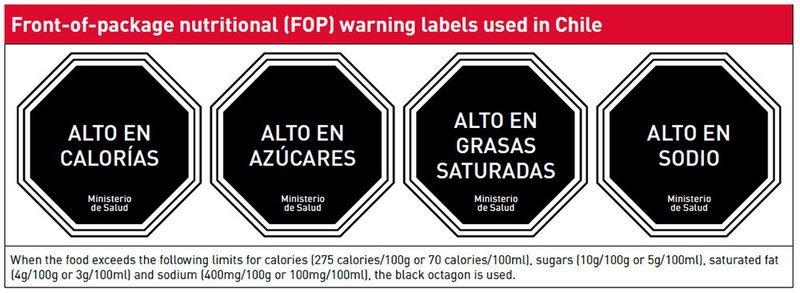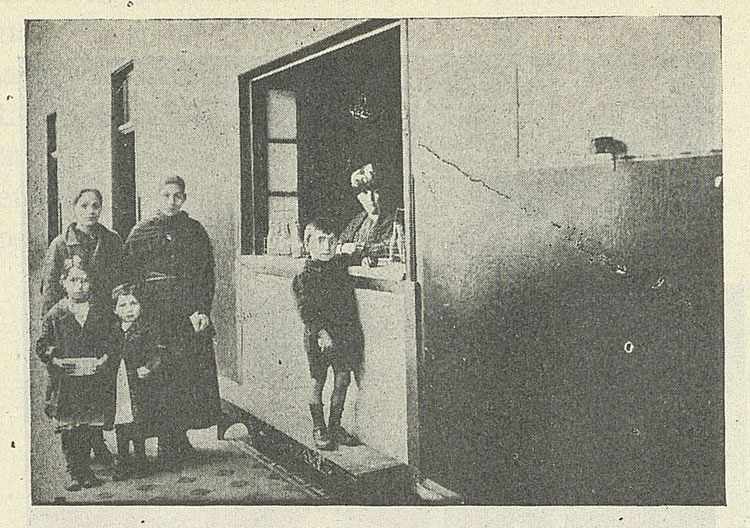 Download this article in magazine layout
Download this article in magazine layout
- Share this article
- Subscribe to our newsletter
How effective are policy interventions in food environments?
In Chile, at the beginning of the 20th century, the main nutritional problems were undernutrition and micronutrient deficiencies, the causal factors of the high child mortality rate in those years. To address these issues, Chile implemented multiple public health policies and programmes, for example fortified flours with folic acid (1950), water with fluorine (1953) and salt with iodine (1979), and it implemented the National Complementary Food Program (1954). This programme provides fortified dairy products for all pregnant women as well as children under six years of age. Today, the prevalence of undernutrition in Chile is three per cent.
However, since the 1990s, Chile has undergone a rapid epidemiologic transition, with an increased prevalence of excess weight and chronic diseases throughout the country. According to the 2016 National Health Survey, 71 per cent of those over 15 years of age were overweight, with this share having increased by 12.4 percentage points from 2003 to 2016. The prevalence of obesity is higher in women (38.4 %). Although among schoolchildren there has been a slight improvement in obesity prevalence, the trend nevertheless prevails that every second child is overweight, making Chile one of the nations with the worst obesity among the countries in the Organisation for Economic Co-operation and Development (OECD).
One of the factors that may explain the increase in obesity is the change in food systems and chains. Added to globalisation, it has generated an obesogenic food environment, with high access and availability to ultra-processed foods, which are rich in salt, sugar and saturated fats. Not only in Chile but world-wide, calories from meats, sugars, oils and fats have increased in the last decade, while those from fruits, vegetables and legumes have decreased. The National Food Consumption Survey conducted in Chile in 2016 shows that 90 per cent of the population require changes in their diet according to the Healthy Eating Index.
Along these lines, Chile stands out in the region for the high and growing level of sales of ultra-processed products and sugary soft drinks, now reaching 646 kcal/person/day. The consumption of sugary drinks is at 7.1 litres/person/month. Ultra-processed foods have characteristics that make them more attractive to people, with hyper-palativeness, less satiety, their comfort, their high glycemic and energy load, their marketing, their portion size, and their lower price standing out among these characteristics. In Chile, ultra-processed foods are easier to access and lower priced than healthy foods. A situation of inequality in their access, consumption and availability depending on the socioeconomic level can be observed. Households at a lower socioeconomic level are more obesogenic environments.
“Food environment refers to the physical, economic, political and socio-cultural context in which consumers engage with the food system to make their decisions about acquiring, preparing and consuming food.” HLPE, 2017
Policies in Chile have focused on the food supply environment. In this sense, public policies are based on and derived from the information provided in the labelling of products and the limits established by the Ministry of Health in the Food Health Regulations for the content of calories, saturated fats, sugars and sodium.
Public policies to improve the food supply environment …
To improve the food supply environment, the following principal policies have been implemented:
- In 1996, the Chilean Food and Health Regulations established norms including definitions for nutrient content, rules on nutrient claims (e.g. “free of” or “low in”) and specific health messages which had been voluntary up to this point.
- In 2006, information per 100 g and portion size for calories, protein, carbohydrates, sugars (since 2014), fats (saturated, monounsaturated, polyunsaturated) and sodium was included. Reference is also made to allergens, and a list of ingredients in quantity-decreasing order and beginning with front-of-package nutritional (FOP) warning labels is given. When the food and beverage products have a high energy, sugar, saturated fat or sodium content, a black octagon (see Figure) with the suffix “alto en” (high in) is used. In addition, this regulation prohibits marketing of “alto en” foods and beverages directed at children and sales of these products in schools.
- In 2014, through Law 20,780, the tax on sugary drinks with more than 6.25 gr of sugar/100 ml was increased from 10 per cent to 18 per cent.

… and their effects on the health of the population

Milk being distributed by the relief organisation Gota de Leche in Viña del Mar, Chile, roughly in 1920. Photo: Biblioteca Nacional de Chile
The policies implemented at the beginning of the century aimed to reduce the prevalence of undernutrition and the child-mortality rate. When undernutrition no longer represented a public health problem and the prevalence of obesity began to increase, policies sought to address the problem from different angles, promoting healthier food environments. Below, some effects are listed that have been observed after the implementation of the public policies mentioned above:
- There have been improvements in the food environment as the food industry modified its products in order to receive fewer seals. Sugar and calorie content was lowered. The percentage of products qualifying for a high-in-sugar label dropped from 80 to 60 per cent, while the proportion qualifying for a high-in-sodium label fell from 74 to 27 per cent.
- Domestic purchases of sugary drinks (i.e. beverages that received the high-in-sugar label) decreased by 11.9 cal./person/day, or 27.5 per cent relative to the counterfactual.
- The purchase of non-sugar-free beverages increased by 5.7 cal./person/day, or a rise of 10.8 per cent relative to the counterfactual.
- There is an overall calorie reduction from purchased beverages of 7.4 cal./person/day, or a decrease of 7.5 per cent relative to the counterfactual.
- The consumption of breakfast cereals with FOP alerts dropped on average by 26 per cent compared to those products without an FOP alert.
- The consumption of non-sugar sweeteners has increased. With 141.2 gr/person/day, Chile is the country with the second-highest sugar consumption world-wide, three times that in the WHO recommendation. In this sense, the front-package alert allowed the food industry to shift from sugar to non-sugar sweetener. A Chilean study found that 56 per cent of products such as dairy cereals, processed fruits, non-alcoholic beverages, sweets and dessert had at least one non-caloric sweetener in accordance with the law. That is a controversial effect because while sugar consumption has decreased, there is no evidence of the non-sugar sweetener having a beneficial effect on human health.
Despite all the efforts made by policy-makers to tackle the public health problem mentioned above, none of them have yielded the results reckoned with – no significant change in the nutritional status of the population has been observed. The cause of obesity is multifactorial, which is why interventions need to address a whole range of aspects. The hypotheses on which ones they include are varied. The sedentary lifestyle in the population is increasing, the Chilean diet is of lower nutritional quality, the commercialisation of unhealthy foods, especially that focused on children, is strong, and the environment has become obesogenic.
What are the next challenges?
Food environments play an important role in the access and availability of food. For this reason, it is important that governments stimulate the marketing of healthy foods in mass dissemination channels. Moreover, taxes on unhealthy foods and subsidies on healthy foods could be implemented. However, according to the evidence, their effect on demand is not yet consistent. In future, the use of non-sugar sweetener in the food supply must always be tracked in association with the implementation of policies such as front-of-package food labels and taxes given the uncertainty about their relationship with health outcomes.
Moreover, it is necessary to improve access to healthy food and increase the availability of fresh markets around the cities. Finally, it is important that the government exercises control and surveillance of food environments, which allows an evaluation of the policies implemented and a generating of new ones based on evidence. In this sense, it is necessary for the government to evaluate the policies implemented and control compliance with them, for example, to see whether products with high content of critical nutrients have a correct FOP alert.
Today, there are no new policies on the country’s public agenda that aim to address obesity or improve food environments. But a group led by academics and members of civil society are seeking to incorporate into Chile's new constitution the right to food based on the components of food security: access, availability, stability, sustainability, and adequacy. In this way, the State would recognise the impact of poor nutrition on the quality of life and well-being of individuals and communities, and would be made responsible for resolving this situation.
Patricia Caro is Assistant Professor at the Health and Wellness Department of the Catholic University of Uruguay. She holds a PhD and an MSc in Public Health.
Contact: Patricia.caro@ucu.edu.uy
References
Barahona, Nano; Otero, Cristóbal and Otero, Sebastián, Equilibrium Effects of Food Labeling Policies (September 23, 2020). Available at SSRN: ssrn.com/abstract=3698473 or http://dx.doi.org/10.2139/ssrn.3698473
Christina A. Roberto, Shu Wen Ng, Montserrat Ganderats-Fuentes, David Hammond, Simon Barquera, Alejandra Jauregui, Lindsey Smith Taillie (2021). The Influence of Front-of-Package Nutrition Labeling on Consumer Behavior and Product Reformulation. Annual Review of Nutrition 2021 41:1, 529-550
Odoms-Young, A., Singleton, C. R., Springfield, S., McNabb, L., & Thompson, T. (2016). Retail environments as a Venue for Obesity Prevention. Physiology & Behavior, 5(2), 184–191. https://doi. org/10.1007/s13679-016-0219-6
Pan American Health Organization (2019). Ultra-processed food and drink products in Latin America: Sales, sources, nutrient profiles, and policy implications. Washington, D.C.: PAHO; 2019.
Quitral V, Arteaga J, Rivera M, Galleguillos J, Valdés I (2019). Comparison of sugar and non- caloric sweetener content in beverages before and after implementing Chilean law 20.606. Rev. Chil. Nutr. 46(3): 245–53
Rodríguez-Osiac, Lorena, Fernandes, Anna Christina Pinheiro, Mujica-Coopman, Maria-F., Caro-Moya, Patricia, & Navarro-Rosenblatt, Deborah. (2021). A description of Chilean food and nutrition health policies. Revista médica de Chile, 149(10), 1485-1494. https://dx.doi.org/10.4067/s0034-98872021001001485
Shankar, P., Ahuja, S., & Sriram, K. (2013). Non-nutritive sweeteners: review and update. Nutrition (Burbank, Los Angeles County, Calif.), 29(11-12), 1293–1299. doi.org/10.1016/j.nut.2013.03.024
Universidad de Chile (2021). “Propuesta Constitucional sobre el Derecho a la Alimentación”. Plataforma UChile Constituyente, Universidad de Chile, Santiago, Chile.





Add a comment
Be the First to Comment